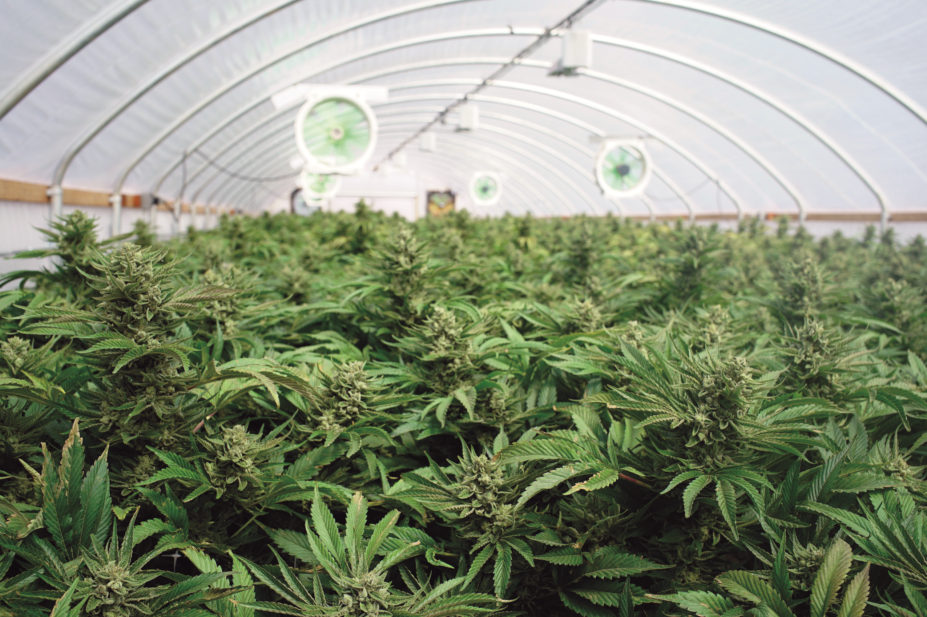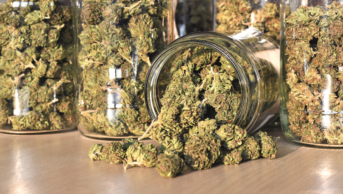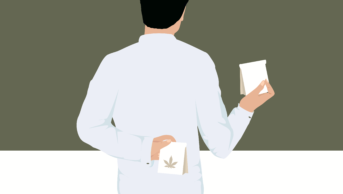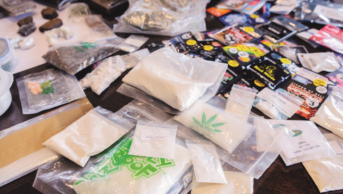
Shutterstock.com
Cannabis
sativa has been domesticated and cultivated by humans over millennia for its fibre, oils and psychoactive properties; throughout history, the resin, leaves and flowers of the plant have been described as having therapeutic activity[1]
.
In Ayurvedic and Chinese texts, cannabinoids — the plant’s natural components — were recommended for the treatment of seizures. The effectiveness of hashish in treating a child with a convulsive disorder was described by physician William Brooke O’Shaughnessy in the 1840s, following observations made in Bengal. And in 1980, Cunha et al. reported anticonvulsant benefits in a phase I trial of cannabidiol (CBD) — the plant’s most commonly identified non-intoxicating cannabinoid[2]
. Over the past few years, several trials have reported that the safety profile of CBD justifies randomised trials in patients with epilepsy who do not respond to conventional strategies[3]
.
Epilepsy, a condition characterised by a predisposition to seizures, is often challenging to treat. Some 60% of cases of epilepsy are thought to have a genetic cause. Seizure control is not always possible using current drug regimens or surgery in about a third of patients[4]
. Seizures that are unable to be controlled are accompanied by the development of brain damage or encephalopathy and an increased risk of mortality and morbidity[5]
. As a result, the management of epilepsy is typically multidisciplinary, routinely involving pharmacists.
Success for severe epilepsy
A particularly distressing form of epilepsy — Dravet syndrome — manifests in the first year of life with seizures and encephalopathy. Initially, the condition resembles one of febrile convulsions, but children develop prolonged seizures as they grow and show developmental delay, movement and balance problems, and sleep disorders.
In 2017, a multicentre international trial randomised 120 children and young adults with Dravet syndrome in a double-blind, placebo-controlled treatment trial with oral CBD or placebo[6]
. All patients had drug-resistant seizures. After a 4-week baseline period on normal therapy, patients underwent a 14-week treatment trial. The median frequency of convulsive seizures reduced from 12.4 to 5.9 in those treated with CBD, while seizure frequency in the placebo group fell from 14.9 to 14.1. The overall condition of patients in the active treatment group improved on a global assessment scale and while 5% of cases became seizure-free in the active treatment group, there were no seizure-free patients in the placebo arm. However, there were some adverse reactions in the CBD group, including diarrhoea, vomiting, fatigue, sleepiness and abnormal liver function tests.
Potential across a range of conditions
The literature suggests that patients with other treatment-resistant epileptic encephalopathies, such as CDKL5 deficiency disorder, Aicardi syndrome, Dup15q, Doose and Lennox-Gastaut syndromes, respond positively to CBD treatment[7],
[8]
. This growing body of evidence suggests that treatment with CBD at recommended doses is safe.
Cannabidiol may be used to reduce blood pressure or treat glaucoma and it may alleviate symptoms of asthma, depression, insomnia and constipation
CBD may also be beneficial in treating patients with other conditions. The compound is claimed to be effective in alleviating neuropathic pain, reducing muscle spasms and treating the nausea associated with chemotherapy. CBD may be used to reduce blood pressure or treat glaucoma and it may alleviate symptoms of asthma, depression, insomnia and constipation[9]
. And early trials are starting to ascertain whether CBD can be used to treat opioid addiction.
Legalising cannabis for medical use
In June 2018, the case of 12-year-old British boy Billy Caldwell — whose mother tried to bring home a cannabis oil from Canada to treat Billy’s epilepsy — brought to the fore a national debate on how families should be able to access cannabis-based preparations to treat their children.
Cannabis is legally scheduled as a Class B drug under the Misuse of Drugs Act 1971, alongside amphetamine, ketamine, codeine and methylphenidate. Cannabis currently sits in Schedule 1 and the use of CBD is legal in the UK if the preparation contains no more than 0.2% delta-9-tetrahydrocannabinol (THC) — the predominant psychoactive component of cannabis. Billy’s cannabis oil, however, contained a large amount of THC and was confiscated at Heathrow Airport. The Misuse of Drugs Act allowed the Home Office to grant access by special licence to a cannabis oil preparation so that Billy “receives the most effective treatment possible in a safe way”; there was, therefore, no ethical or scientific reason not to use a proven therapy, but a legal one.
As the Caldwell story unfolded, the US Food and Drug Administration licensed the first cannabis-derived medicine — Epidiolex (GW Pharmaceuticals) — for the treatment of Lennox-Gastaut syndrome or Dravet syndrome in children aged over two years. And, in other countries, pharmaceutical-grade cannabinoid medicines that contain more than 50% THC are already available, such as Sativex (Bayer) for the treatment of multiple sclerosis.
Following a review of the evidence by the UK Advisory Council on the Misuse of Drugs, Dame Sally Davies, chief medical officer for England, recommended that the “whole class of cannabis-based medicinal products be moved out of Schedule 1” and that doctors should be able to prescribe them. Prescription of compounds with levels of THC greater than 0.2% may, therefore, become possible in the UK.
There are regrettably few pre-clinical or clinical trials of CBD, and dose-response curves and dosage regimens have not yet been developed
In the event of cannabis-based products becoming available for prescription, pharmacists will require considerably more information relating to the safety, adverse effects and drug interactions of THC if they are to develop their role as educators and communicators of the products. But clinical data relating to therapies containing THC are currently not as robust or as well founded as that to support CBD. The challenge will be to establish the strength of the current evidence for these therapies.
Lack of data
There, however, is a paucity of CBD data. There are regrettably few pre-clinical or clinical trials of CBD, and dose–response curves and dosage regimens have not yet been developed. Also, the relative efficacies of CBD as part of combination therapies have not yet been published. However, adverse events with CBD, including raised transaminases and several drug interactions, are reported as being well tolerated in patients[10]
. How might adverse reactions and drug interactions be reduced? Or might we find ways of manipulating the body’s endocannabinoid system with other agents? Further trials should follow.
Long-term effects of CBD on the brains of children with epilepsy have not been studied, although if CBD reduces seizures, any risk–benefit ratio is likely to be strongly in favour of its use. The scientific and ethical arguments are not yet transferable to botanical preparations containing more than 0.2% THC, owing to the current lack of published good quality evidence.
But cannabis could prove itself to be a botanical treasure trove offering great potential for innovative new therapies for many complaints, not just seizures. Natural products have often led to transformative approaches to healthcare and, with investment in collecting safety and dosing data, Cannabis sativa could do the same.
Colin Michie is associate dean of academic affairs at the American University of the Caribbean Medical School, St Maarten, Netherlands Antilles; paediatrician; fellow of the Royal College of Paediatrics and Child Health.
Ashlyn Brown is a medical student at the American University of the Caribbean Medical School, St Maarten, Netherlands Antilles.
Correspondence to: colinamichie@gmail.com
References
[1] NHS. Epilepsy: treatment. 2017. Available at: http://www.nhs.uk/Conditions/Epilepsy/Pages/Treatment.aspx (accessed September 2018)
[2] Cunha JM, Carlini EA, Pereira AE et al. Chronic administration of cannabidiol to healthy volunteers and epileptic patients. Pharmacology 1980;21(3):175–185. doi: 10.1159/000137430
[3] Devinsky O, Marsh E, Friedman D et al. Cannabidiol in patients with treatment-resistant epilepsy: an open-label interventional trial. Lancet Neurol 2016;15(3):270-278. doi: 10.1016/S1474-4422(15)00379-8
[4] Laxer KD, Trinka E, Hirsch LJ et al. The consequences of refractory epilepsy and its treatment. Epilepsy Behav 2014;37:59–70. doi: 10.1016/j.yebeh.2014.05.031
[5] Russo EB. History of cannabis and its preparations in saga, science, and sobriquet. Chem Biodivers 2007;4(8):1614–1648. doi: 10.1002/cbdv.200790144
[6] Devinsky O, Cross JH, Laux L et al. Trial of cannabidiol for drug-resistant seizures in the Dravet syndrome. N Engl J Med 2017;376(21):2011–2020. doi: 10.1056/NEJMoa1611618
[7] Devinsky O, Verducci C, Thiele EA et al. Open-label use of highly* purified CBD (Epidiolex®) in patients with CDKL5 deficiency disorder and Aicardi, Dup15q, and Doose syndromes. Epilepsy Behav 2018; pii: S1525-5050(18)30191-4. doi: 10.1016/j.yebeh.2018.05.013
[8] Hussain SA, Zhou R, Jacobson C et al . Perceived efficacy of cannabidiol-enriched cannabis extracts for treatment of pediatric epilepsy: a potential role for infantile spasms and Lennox-Gastaut syndrome. Epilepsy Behav 2015;47:138–141. doi: 10.1016/j.yebeh.2015.04.009
[9] Mücke M, Phillips T, Radbruch L et al . Cannabis-based medicines for chronic neuropathic pain in adults. Cochrane Database Syst Rev 2018;7;3:CD012182. doi: 10.1002/14651858.CD012182.pub2
[10] Gaston TE, Bebin EM, Cutter GR et al . Interactions between cannabidiol and commonly used antiepileptic drugs. Epilepsia 2017;58(9):1586–1592. doi: 10.1111/epi.13852


